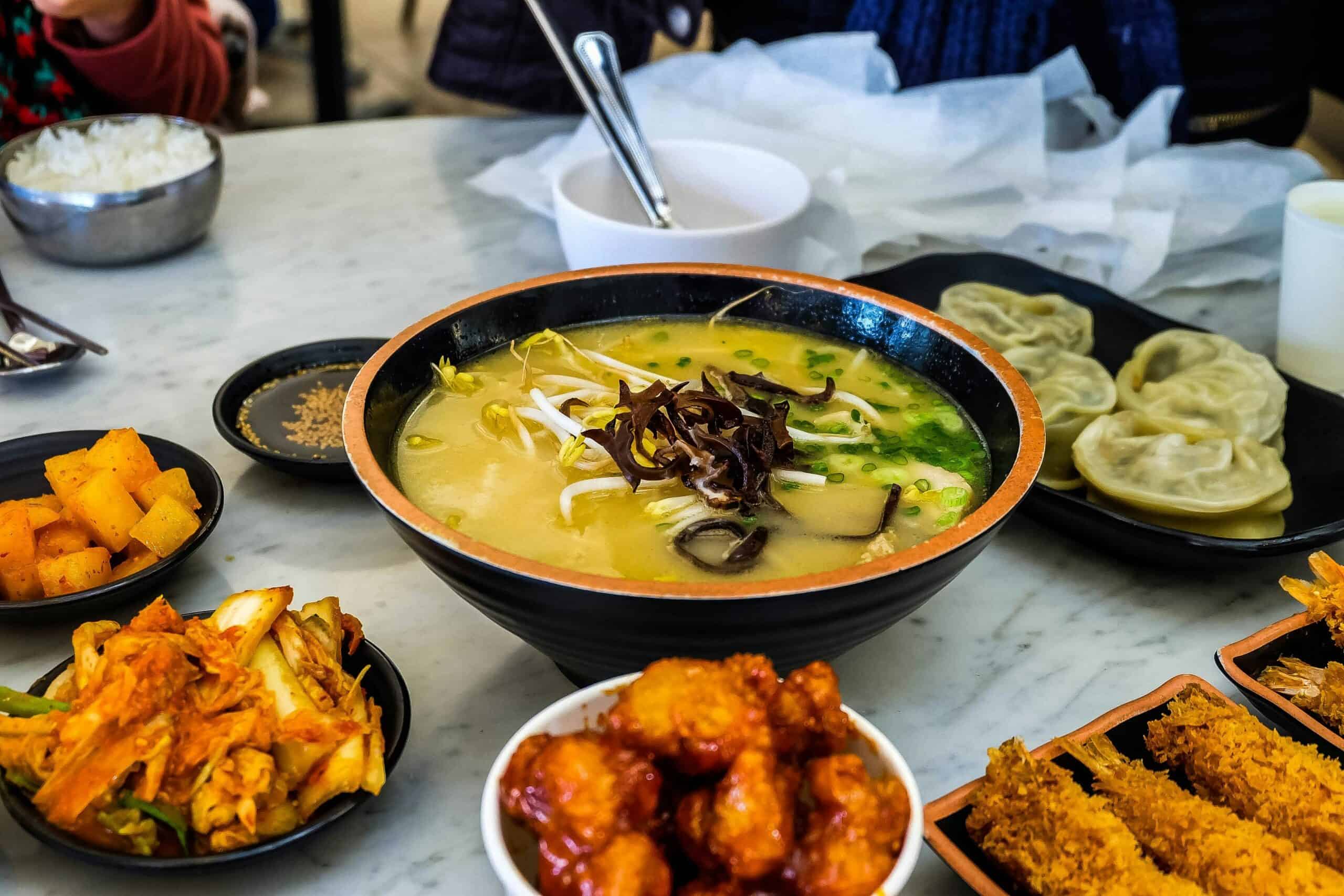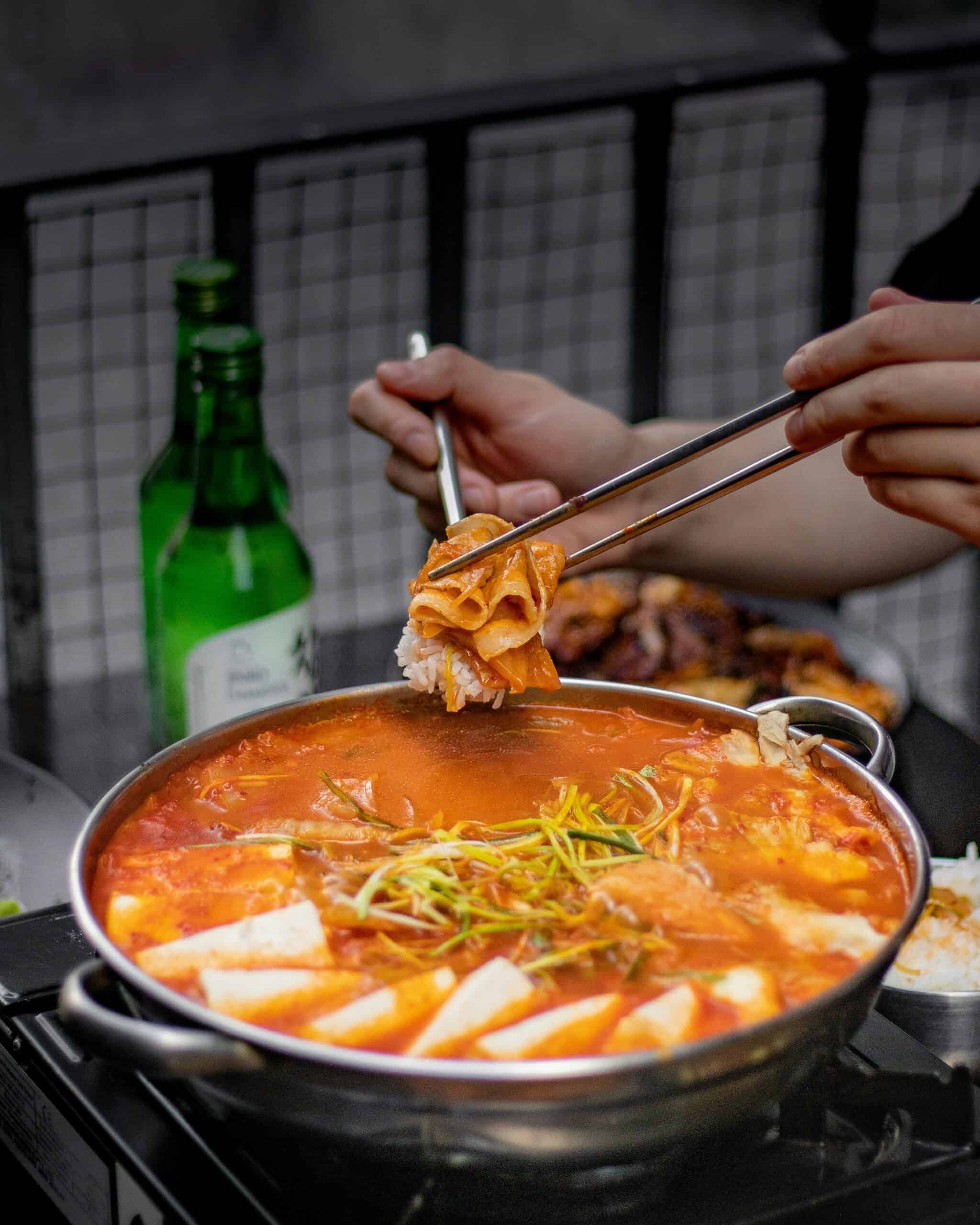As evenings turn crisp and markets fill with sweet potatoes, chestnuts, and glossy persimmons, Korean comfort food slides into season with broths that hum with umami, pancakes that crackle on the griddle, and street-style treats that warm your hands as much as your mood.
These 6 dishes capture the cozy side of Korean cooking, balanced heat, deep flavors, and textures that make chilly nights feel like an invitation to linger at the table.

Jump to:
😌 What Makes Korean Fall Food So Comforting?
Korean cold-weather dishes lean on slow warmth rather than blunt heat: spice that blooms but never bullies, chewy textures that feel satisfying without being heavy, and stocks layered with dried anchovy, kelp, and mushrooms to build depth.
Autumn produce—kabocha pumpkin, radish, scallions, and mackerel—meets pantry foundations like gochujang (chili paste), doenjang (soybean paste), and gochugaru (Korean chili flakes). There’s also ritual: pancakes paired with milky makgeolli on rainy afternoons, a pot of stew anchored at the center of the table, and pockets of street food that promise quick comfort between errands.
🧡 The 9 Cozy Dishes
1) Kimchi-jjigae (김치찌개)
Why it’s cozy: A tangy, spicy stew where well-fermented kimchi mellows into a rich broth.
How to try at home: Sauté kimchi with a little pork belly or canned tuna, add anchovy-kelp stock, simmer with tofu and onion, then finish with a few slices of chili.
PH swap: Local firm tofu and good bottled kimchi work; add a splash of patis (fish sauce) if the kimchi is mild.

2) Doenjang-jjigae (된장찌개)
Why it’s cozy: Savory, miso-adjacent depth from fermented soybean paste, rounded by mushrooms and squash.
How to try at home: Dissolve doenjang in hot stock, add zucchini or squash, mushrooms, onion, and tofu; simmer gently and finish with scallions and a drizzle of toasted sesame oil.
PH swap: Squash stands in beautifully for Korean pumpkin; dried shiitake amplifies umami.
3) Dak-bokkeumtang / Dakdoritang (닭볶음탕)
Why it’s cozy: One-pot braise of chicken, potatoes, and carrots in a glossy, spicy-savory sauce.
How to try at home: Brown chicken, add aromatics, gochujang, soy, sugar, and water; simmer with potatoes and carrots until the sauce clings.
Weeknight move: Use bone-in thighs for richer flavor and shorter simmer time.
4) Pajeon (파전)
Why it’s cozy: Scallion pancakes with crisp edges and a tender center, rainy-day classic.
How to try at home: Mix a light batter (flour + rice flour + cold water + pinch baking powder), scatter long scallions in a hot pan, pour batter, and fry until lacy. Serve with soy-vinegar-sesame dipping sauce.
Pro touch: A handful of seafood (haemul) turns it into a meal.

5) Kimchi-jeon (김치전)
Why it’s cozy: A punchier cousin to pajeon—zingy, tangy, and fast.
How to try at home: Chop kimchi and fold into batter with a spoon of kimchi juice for color; pan-fry thin so the edges get frilly.
Leftover magic: Add the last bits of aging kimchi here, its acidity shines.
6) Hotteok (호떡)
Why it’s cozy: Chewy pancakes stuffed with brown sugar, cinnamon, and crushed nuts that melt into syrup inside.
How to try at home: Yeasted dough or an easy baking-powder dough, fill, seal, and press gently while pan-frying until the center bubbles. Best eaten too hot to wait.
Air-fryer note: Possible, but pan-fried gives superior chew.
🧑🍳 Build-Your-Own Cozy Menu (Pick from These 6)
1) Weeknight Warm-Up (balanced & fast)
- Main: Doenjang-jjigae
- Side: Pajeon (scallion)
- Sweet finish: Hotteok
- Why it works: Savory soybean depth + crisp pancake texture, then a warm, chewy dessert to close.
2) Rainy-Day Comfort (spicy & satisfying)
- Main: Kimchi-jjigae
- Side: Kimchi-jeon (thin, frilly edges)
- Sweet finish: Hotteok
- Why it works: Layered kimchi tang in both stew and pancake for extra coziness; sugar-cinnamon hotteok balances the heat.
3) One-Pot Hearty
- Main: Dak-bokkeumtang (braised chicken, potatoes, carrots)
- Side: Pajeon (add a handful of seafood if desired)
- Sweet finish: Hotteok
- Why it works: Glossy, saucy braise + crispy pancake = comfort; dessert keeps it feel-good without more cooking.
Quick Pairing Tips
- Rice: Serve jjigae and dak-bokkeumtang with plain steamed rice.
- Dips: For jeon, mix soy : vinegar : water (1:1:1) with a pinch of sugar, sesame seeds, and sliced chili.
- Drink: Makgeolli on rainy days; roasted barley tea (bori-cha) for a non-alcoholic option.
- Heat control: Tone down kimchi-jjigae/dak-bokkeumtang with extra stock or a little sugar; turn up with a pinch more gochugaru.
❓ Frequently Asked Questions
Spice levels vary; most can be adjusted by reducing gochugaru and gochujang or balancing with a little sugar and extra stock.
Kimchi, seasoned spinach (sigeumchi-namul), pickled radish (danmuji), and simple sesame-salt cucumbers add brightness and crunch.
Yes, but expect a firmer crust; pan-frying yields the classic chewy-gooey center.





Comments
No Comments